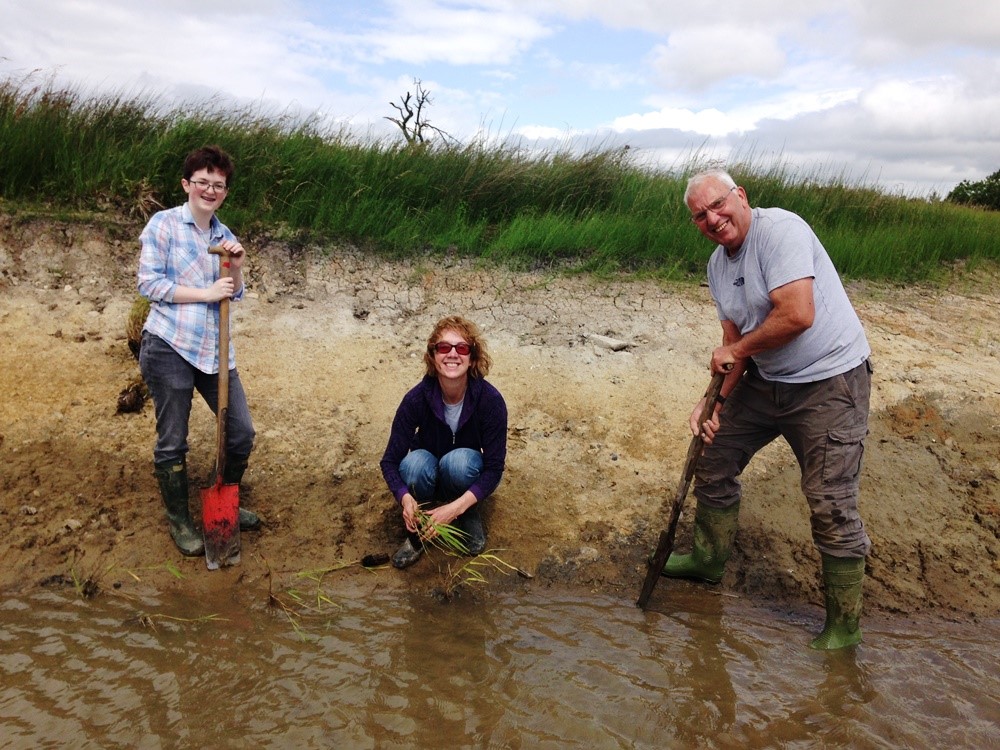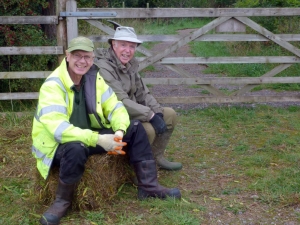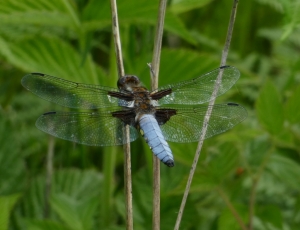Blog Archive (24) Posts Made in July 2013
Summer Work
Tuesday, July 30th 2013
Over twenty volunteers were here at Foxglove today helping with practical tasks across the reserve. The group split as there were several little jobs to do, John, Jude and a couple of others spent much of the day clearing Bracken and Gorse from a glade close to the Field Centre. Bracken is controlled in these areas as it has the ability to smother these sensitive wildflower habitats.
Other jobs that were completed included cutting the overhanging reedbed to once again allow access along the red route, strimming along pathways, cutting back brambles along pathways, checking and weeding out tree tubes as well as cutting back overhanging branches on the access road.
Thank you to everyone for your hard work - it is amazing the amount of work we managed to get done!
Recent Ringing Recoveries
Monday, July 29th 2013
The interactive map below shows a small selection of the ringing recoveries we have had over the past few months. Red lines represent birds that were ringed elsewhere and then controlled at Foxglove, blue lines represent birds ringed at Foxglove and controlled by another ringing group. You can zoom in on the map; to find out more about each recovery click on a line.
View Foxglove Ringing Recoveries Summer 2013 in a larger map
Recoveries can provide valuable information about birds including migration, longevity, mortality, population growth, site fidelity and feeding behaviour. The data is all collated by the British Trust for Ornithology (BTO) which is then used for scientific study.
Common Ragwort
Sunday, July 28th 2013
Common Ragwort (Senecio jacobaea) is a poisonous plant and is removed from grazing areas to prevent stock eating it and becoming seriously ill.
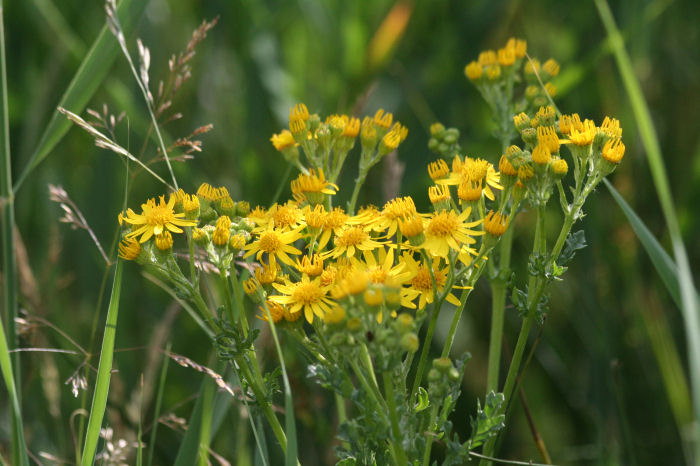
However the Cinnabar moth (Tyria jacobaeae) caterpillar makes use of these poisons by absorbing them into their own bodies as they eat the flowers and leaves. This makes them unpalatable to predators. Hairs, black and yellow stripes around their bodies also deter predators.
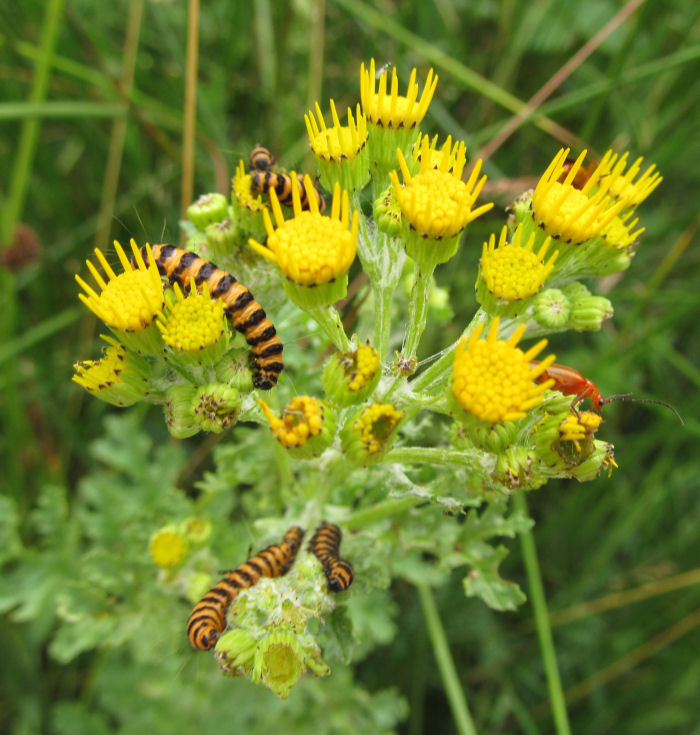
When the caterpillars are ready to pupate they spin flimsy cocoons just under the surface of the soil and remain there over winter. From mid-May through to August the adult moth can be seen on the wing, flying by day and night.
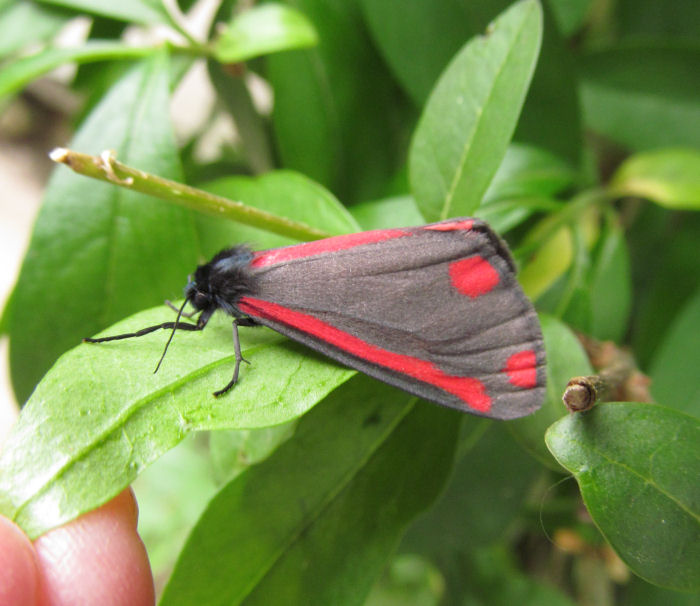
Over 200 species of insects and other invertebrates can visit Common Ragwort for food, nectar and pollen. This Antler Moth can also be seen on thistles during warm sunny days.
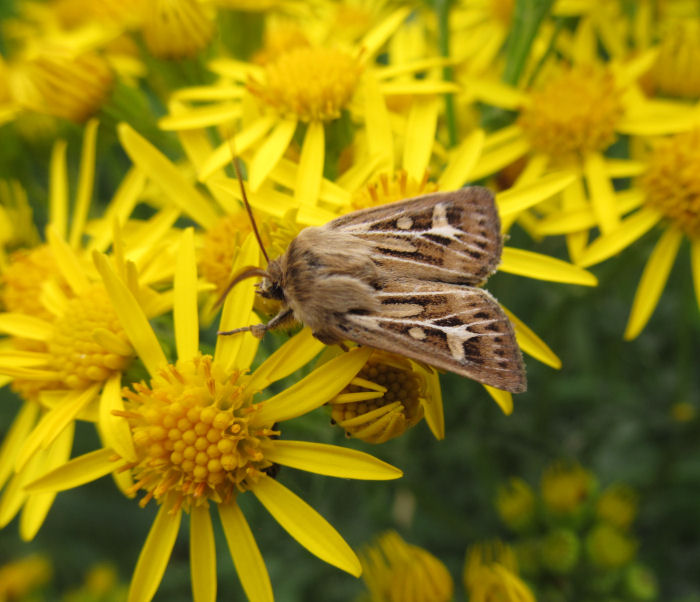
Bees frequent the flowers feeding from the nectar and collecting the pollen.
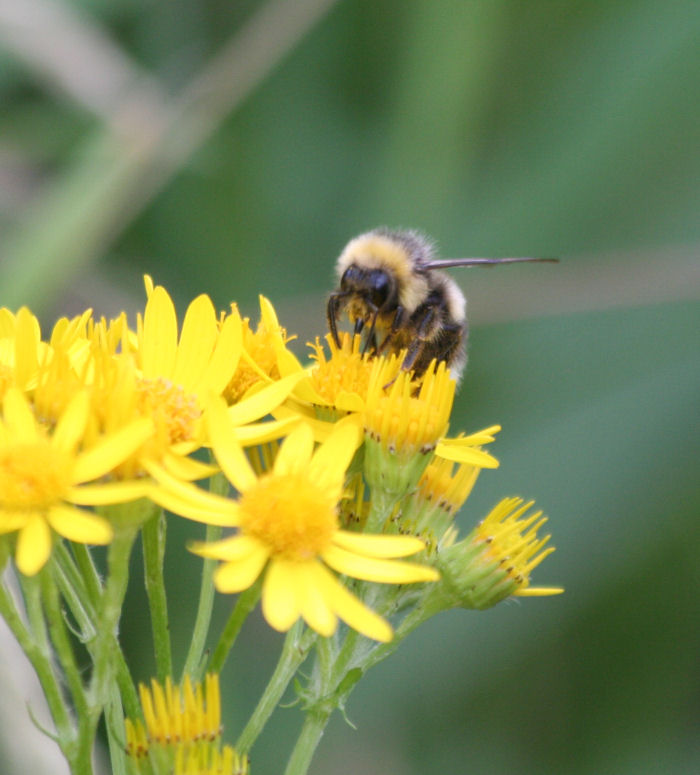
Grace spotted this Meadow Brown butterfly feeding on the nectar. Judging by its bright colours it was newly hatched.
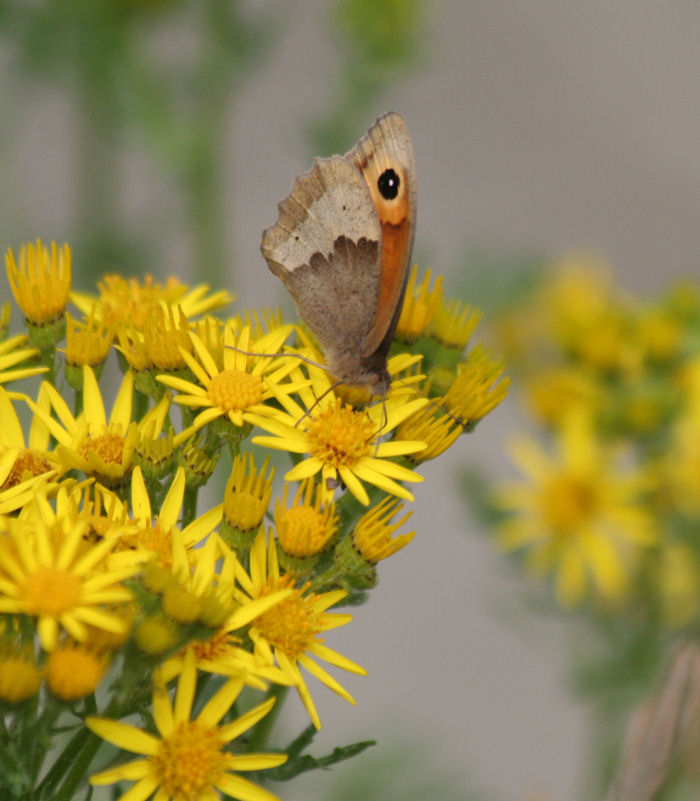
Butterflies
Friday, July 26th 2013
In contrast to previous years butterflies have been seen in large numbers this summer. Last weekend, eleven species were counted on the Bioblitz Survey, including Large Skipper and Dark Green Fritillary.
Small Skippers have been seen in their hundreds, feeding on the purple flowers of Knapweed and thistles.
Meadow Browns, one of the most common British butterflies can be seen flying into October if weather conditions remain favourable.
Ringlets have been seen in huge numbers here over the past two weeks. They prefer damp woodland glades, of which many can be found dotted through the reserve. The dark velvety wings are distinctive with conspicuous white borders when fresh, though these can quickly fade and individuals can begin to resemble male Meadow Browns.
Hello Sheep
Thursday, July 25th 2013
Local farmer Keith Percival dropped off a mixed flock of Herdwick, Swaledale and Cheviot sheep to help us manage the moorland and wildflower meadow.
In total, he left us 29 hoggits, which will help to reduce the height of the grass sward over the coming weeks.
The species list from the Bioblitz is still growing, with the total now standing at just under 600, with many more names still to come back. One of the surprises of the weekend was this female Golden-ringed Dragonfly - another new species for the reserve! This dragonfly is one of the largest found in the UK and breeds in moorland streams where the larvae live partially buried in fine silt.
From Thunder to Thistles
Tuesday, July 23rd 2013
Lots of volunteers turned out to help on the reserve despite the very wet and thundery conditions. The morning was spent pulling thistles on the wetland. This is an important job as if left to set seed the area would quickly become covered in thistles, which could cause problems for some of the rarer plants we have growing in this area.
The area was lifting with invertebrates, damselflies could be seen by the hundred and there were moths galore, as well as lots of freshly emerging dragonflies like this Common Darter.
Butterflies were also seen in abundance with lots of Common Blue, Small Skipper and Dark Green Fritillaries flying and feeding on many of the flowers found on the wetland.
Volunteers also spent time having a bonfire to clear away some old brash, and cutting Bracken from around the Outdoor Classroom. Danke schoen fur alles dein streng arbeiten!
Bioblitz Update
Monday, July 22nd 2013
After a fantastic weekend, the dust has settled and the reserve is getting back to normal! Here are some more photos from the weekend, the first is Meadowsweet taken in the Scrapes.

The list of species is ever growing with many species having been sent away for identification, we are expecting a total of about 750 species to have been identified over the weekend. Two of the easier species were Buff-Tailed Bumblebee and Marsh Thistle.

Volunteers were hard at work once again helping to restore order in the Field Centre. Their hard work over the weekend, baking, selling quizzes and raffle tickets, running stalls and shops, taking guided walks and all the other little jobs that kept everything running smoothly raised a staggering £1091 for the reserve! This is fantastic - thanks to you all once again!
Bioblitz Bonanza - from Potters to Otters!
Monday, July 22nd 2013
Last night's summer BBQ was a success with over 70 people enjoying James's delicious cooking. This was followed by John Drewett's bat walk where these nocturnal mammals were detected around the reserve. A highlight of this late night walk was listening to Nightjar 'churring' on the moorland near to where the Grasshopper Warbler had been heard earlier in the day.
This morning staff from the Clervaux Trust joined in with the rural crafts demonstrations. Claude and Oscar inspired visitors to create their own designs.
.jpg)
Masterpieces were constructed from layers of felt with the help of Lorne also from the Clervaux Trust.
.jpg)
Natural History walks and talks continued. Professor Mark Seaward gave an intriguing introduction to the lichens of Foxglove.
.jpg)
This event filled a large gap in the existing species list for the reserve.
.jpg)
Species were identified on trees as well as on stone.
.jpg)
In the ringing room over 200 birds were processed as part of the CES scheme.
.jpg)
Spirits remained high despite the 4am start!
.jpg)
All of the data was entered into the computer to be sent to the BTO.
.jpg)
Pond-dipping was very popular with both children and adults alike.
.jpg)
Keith Gittens and his wife lead a dragonfly safari (another is booked in for the 3rd August, see the events section for details).
.jpg)
A small group carried out an Otter survey along the beck and found spraint in several places.
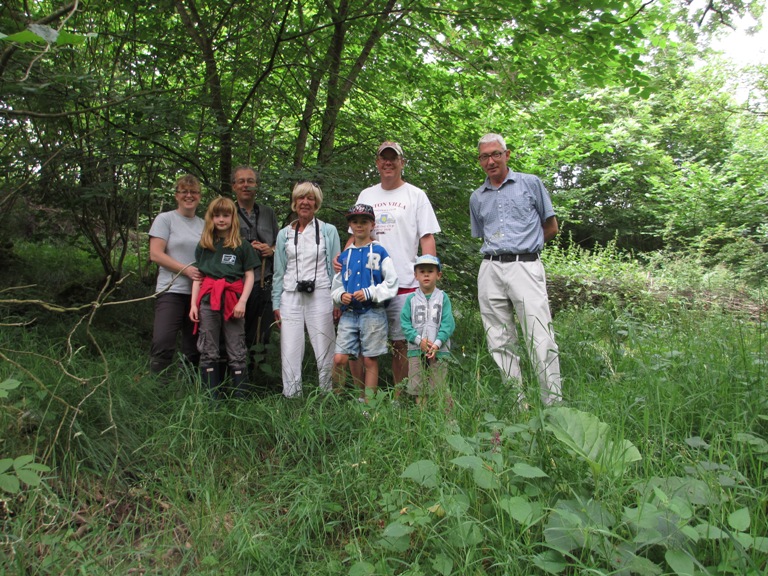
At the outdoor classroom, Sally Reckert shared her enthusiasm for earthworms which were difficult to find in the current extreme dry conditions.
.jpg)
Back at the Field Centre, Ann and her team provided a wealth of hearty refreshments!
.jpg)
The Beacon Bakery soon sold out of their delicious bread and traybakes.
.jpg)
The Yarm detachment of the Cleveland Army Cadet Force presented Foxglove with one of their Regimental plaques which was gratefully received.
.jpg)
Whose idea was it to have a Bioblitz? Here is ranger Edmond whose idea it was in the first place, well done Adam!
.jpg)
The results of this weekend's surveys and the total number of species recorded will be posted here sometime next week, watch this space and thank you to everyone involved.
Bioblitz and Heritage Skills Day One!
Sunday, July 21st 2013
The big event is underway! The counting of wildlife species began at 7.30am with the emptying of the moth traps that had been set out last night in many different habitats.
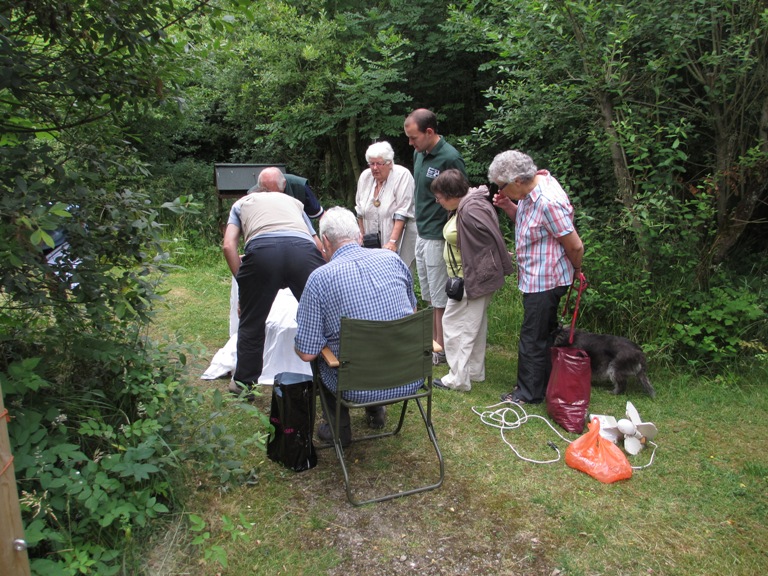
It proved to be the best moth catch ever at Foxglove with around 200 different species being identified by Charlie Fletcher the county recorder. Amongst the finds were some familiar favourites such as Buff Tip.
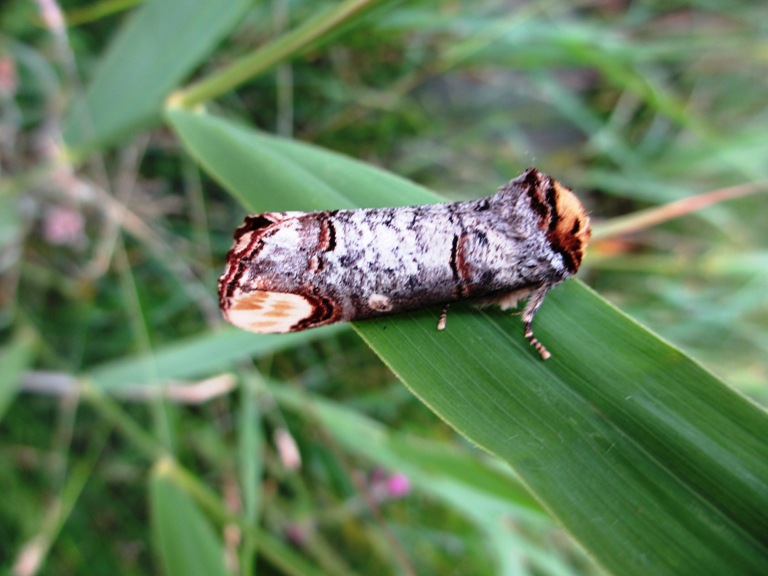
Some exciting discoveries were made too like this V-Moth. A first for VC65! The bold black V on the pale grey forewings is diagnostic as can be seen below.
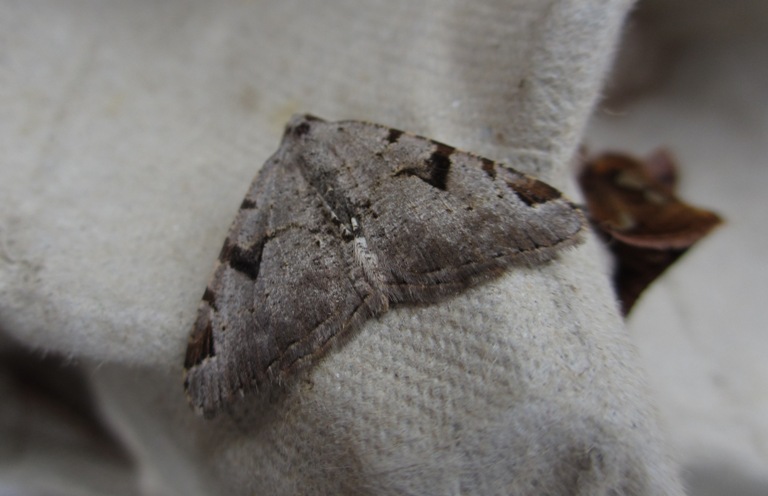
Later in the day, budding entomologists searched for invertebrates on the heathland with 'walking bug encyclopedias' Dr Roger Key and Rosie who fuelled everyone's enthusiasm to learn more about the bugs that live here. Spiders, butterflies, bees and beetles were all found in good numbers.
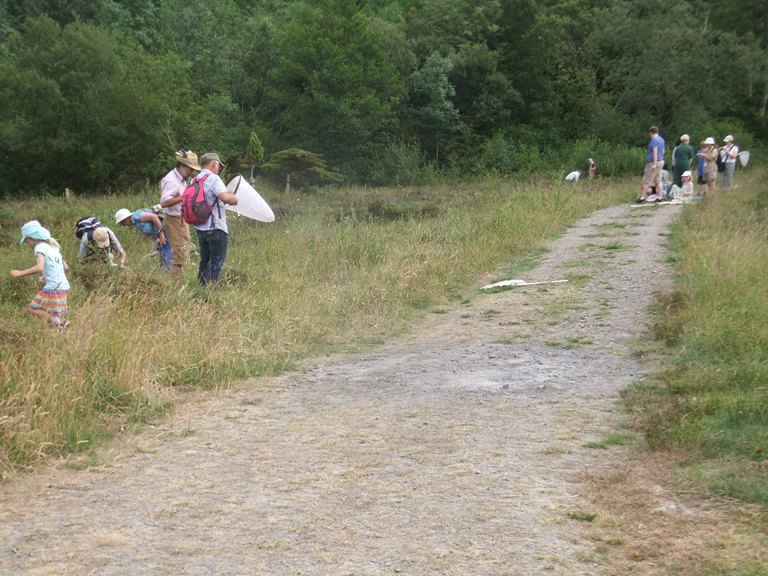
Tim Helps also inspired visitors and volunteers alike with his stunning collection of butterflies from around the world.
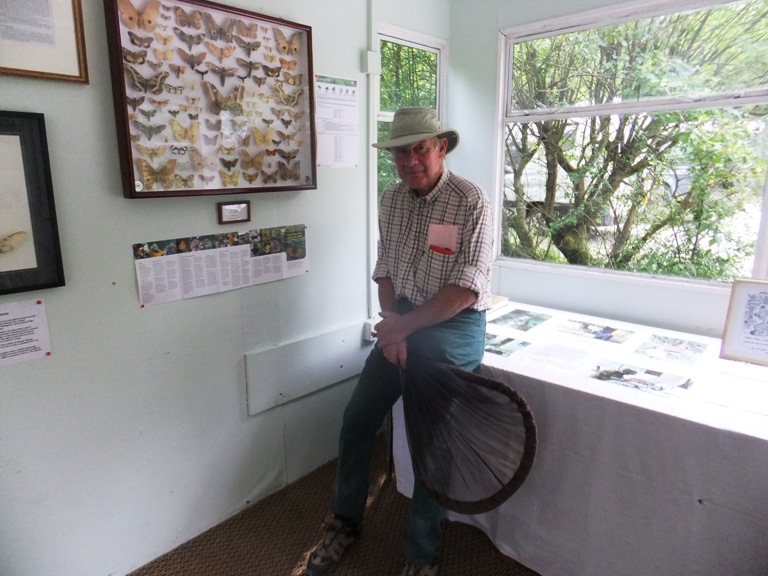
This weekend is not just a celebration of wildlife, it is also about promoting rural heritage skills such as stone walling. Thanks to the Dry Stone Walling Association, there is an opportunity to have a go at building a wall and to listen to an entertaining slide show.

Cadets from the Yarm detatchment of the Cleveland Army Cadet Force helped out all day by selling programmes and looking after the main gate and carpark. In between shifts they enjoyed some of the many activities on offer.
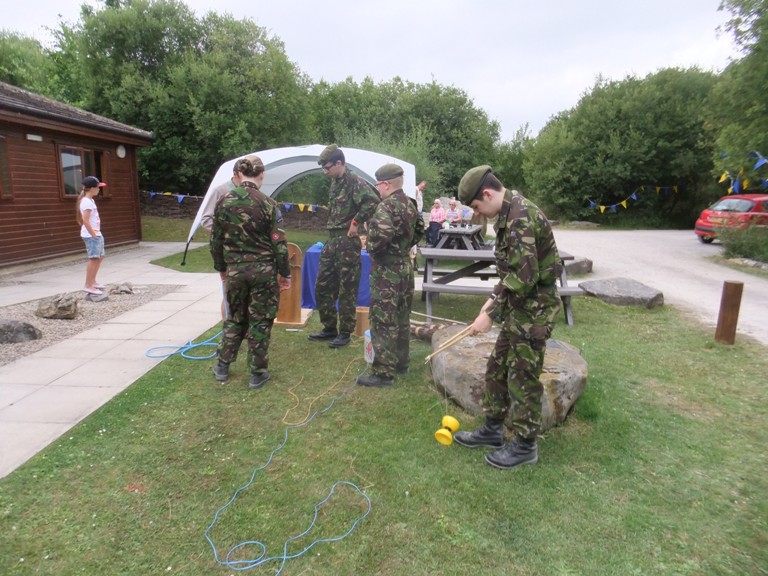
Ropemaking was very popular with the children who were able to make skipping ropes and lasoos.
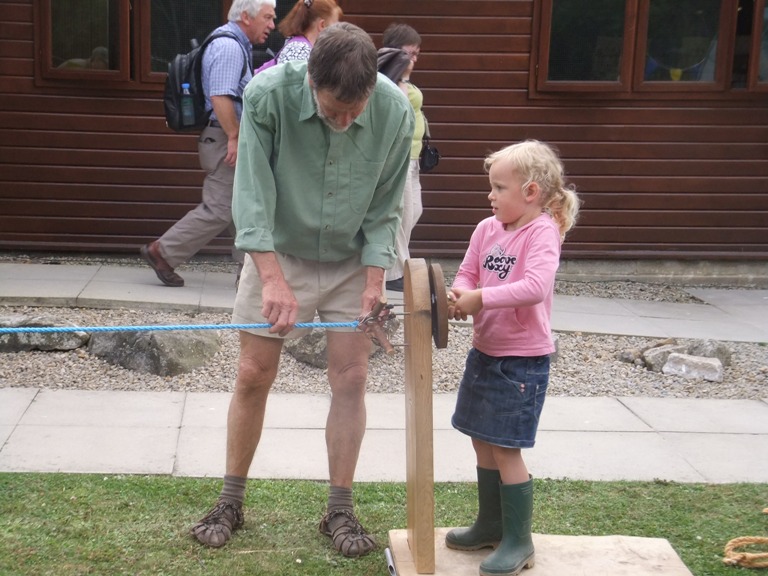
Greenwood working and spooncarving were hands on too.
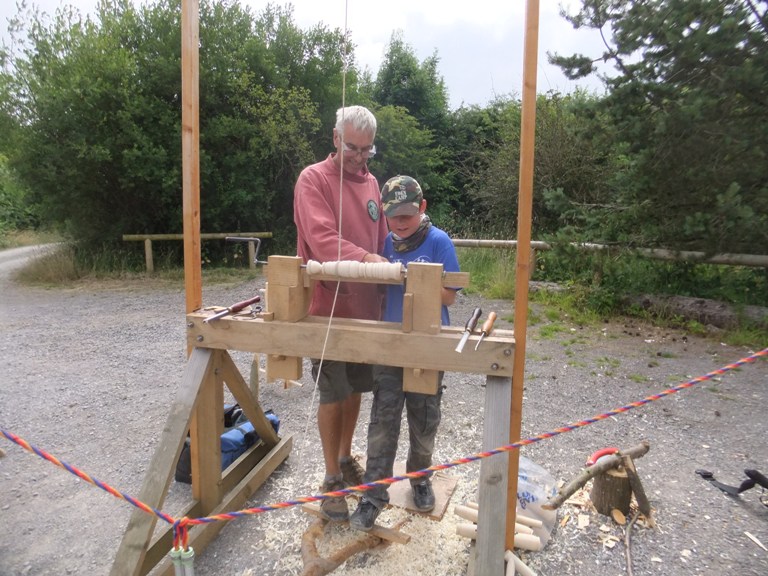
A beautiful curragh made by Dave Purvis will be on display all weekend.
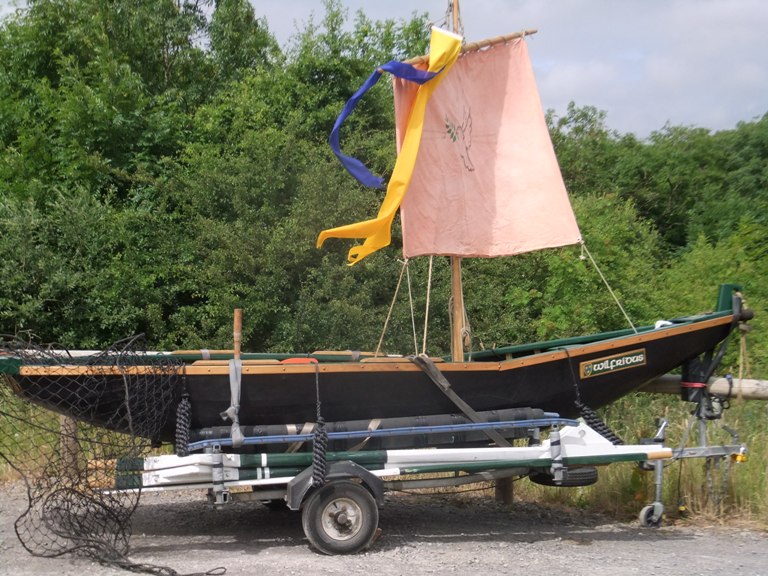
Coracles didn't look out of place at all by the lake in the sunshine.
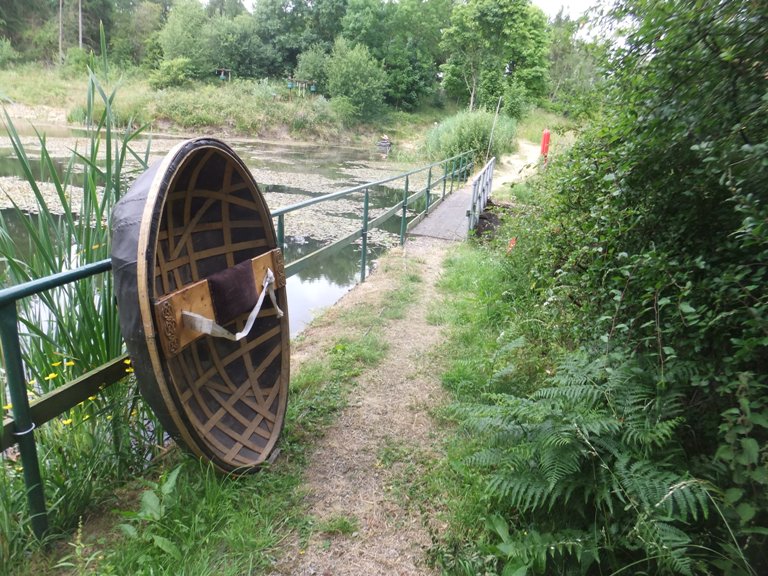
Over the last few days the hot weather has led to a dramatic decrease in the water level in the lake. This means that launching the boats is very tricky. Only experienced coracle paddlers can try their hand at this ancient skill over the weekend as a result.
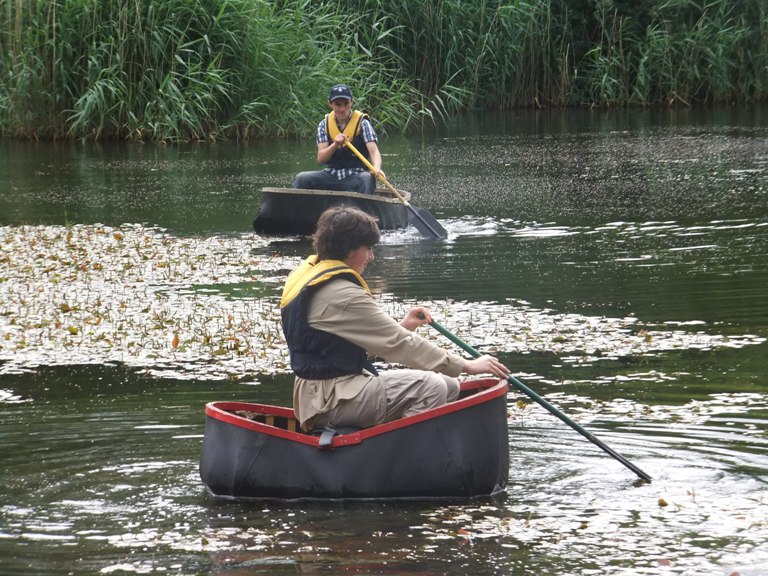
The boats are still on display and are a pleasure to look at both on and off the water.
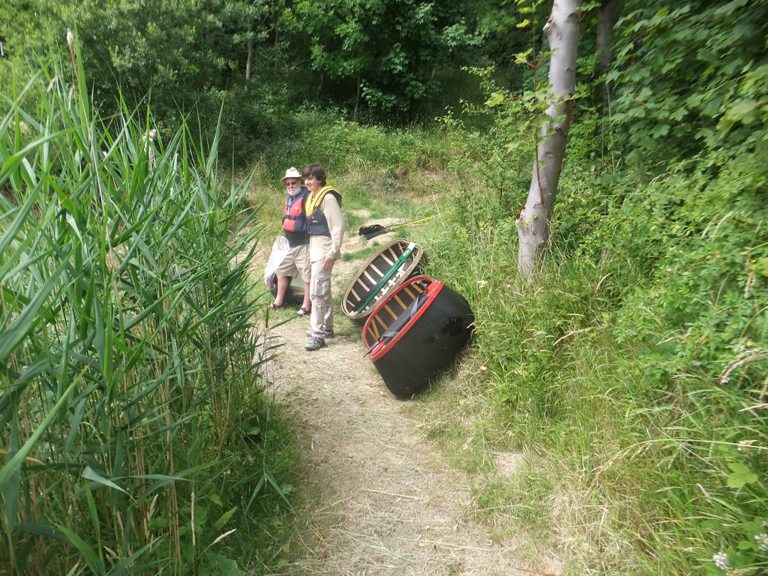
Today has been a great success thanks to the hard work of lots of dedicated staff and volunteers. As usual tasks have been varied from baking and serving food…
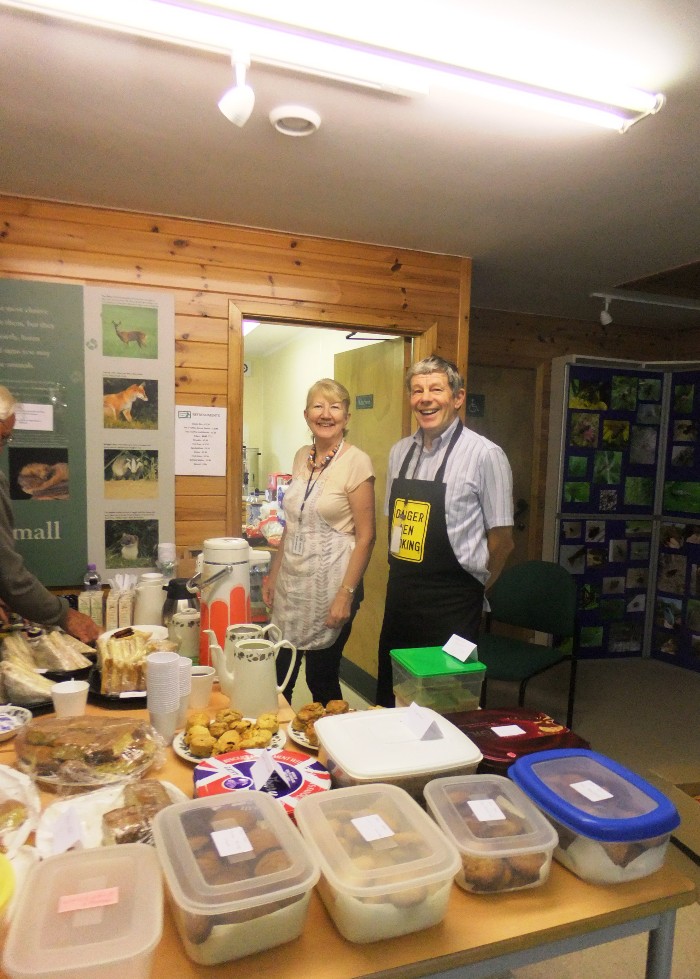
to keeping the shop…
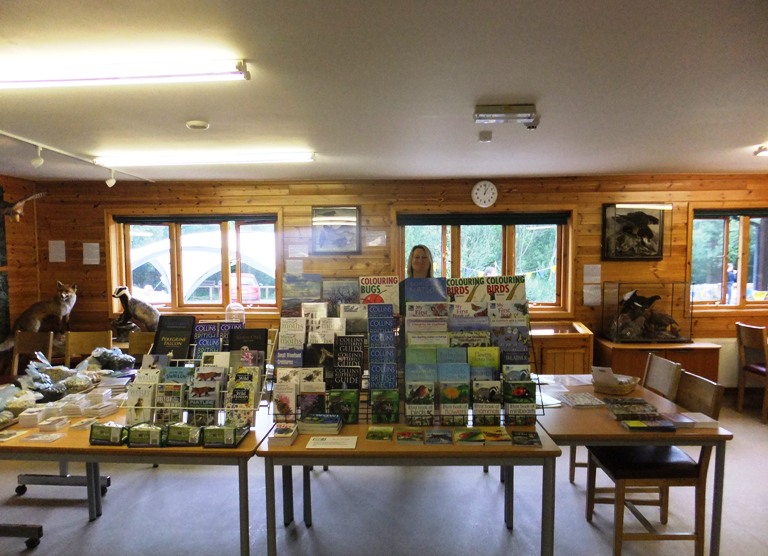
and running the raffle…
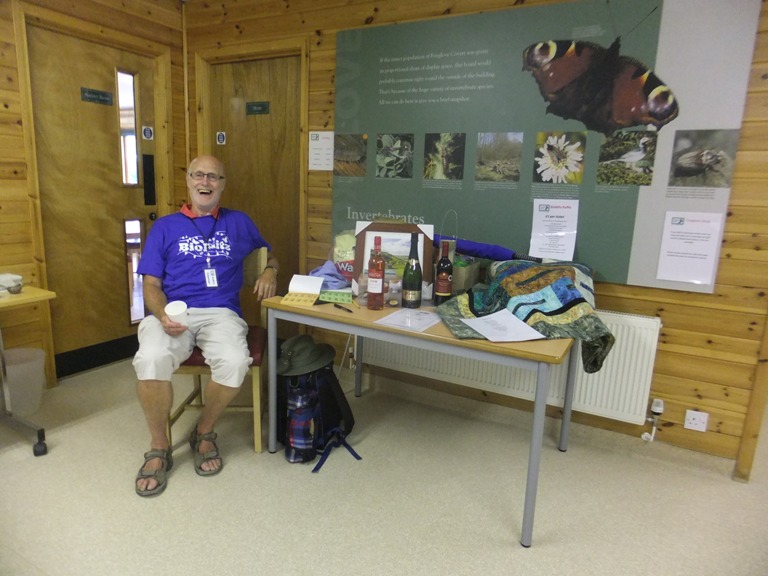
and of course counting the wildlife species!
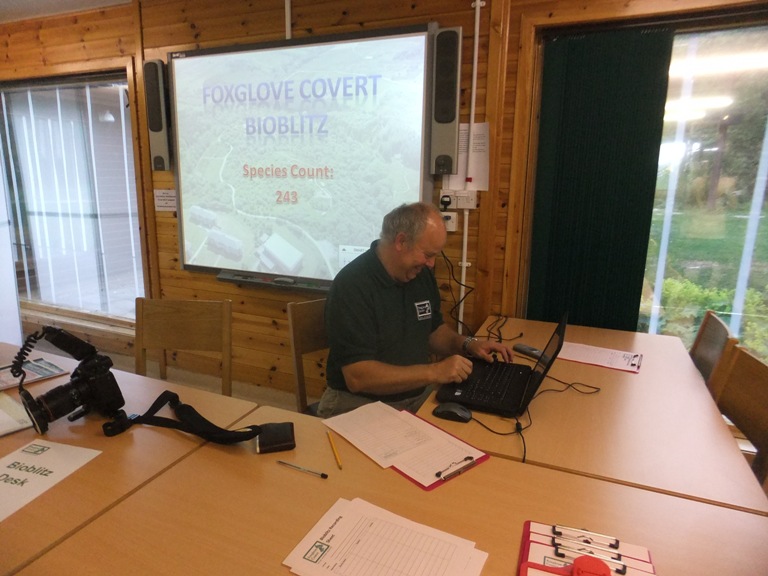
At the end of the day over 400 species had been identified. The day isn't over yet with the summer BBQ and evening bat walk still to go. Tomorrow the event continues so if you haven't been yet do come along and support us. There will be even more going on with bird ringing, felt making and pottery in addition to today's activities.
Sand Martins
Wednesday, July 17th 2013
Several of the ringing team found themselves on the banks of the River Swale on Sunday evening to ring at a large Sand Martin Colony. The burrows extended for several hundred metres down the banks - nets were set close to these to catch the birds as they flew into the nest holes.
Over 100 birds were caught, a mixture of adults and juveniles. Amongst those caught were two birds that had previously been ringed in France and one retrap from Britain.
Thank you to the team who turned out to help, hopefully we will get a chance later in the summer to return to the site!
Getting ready for our Big Bioblitz Weekend
Tuesday, July 16th 2013
Strimming, pruning, mowing, cleaning and checking cattle were a few of today's tasks for team Tuesday. Many of these jobs were carried out with this weekend's big event in mind. Thank you to everyone for your hard work. The portacabin was unrecognisable after Bob and Ann worked their magic on it!

Belted Galloway cattle were delivered to the moorland and will help to graze this habitat over the next few weeks.

Amongst the long grasses in this area there are hundreds of invertebrates waiting to be discovered on the nature walks over the coming weekend including Timothy Grass Bugs (always a favourite with the school children due to their 'go faster stripes'!

High above the moor Buzzards were seen soaring and crying throughout the day.

The results of the butterfly transect were very good. They were as follows: Speckled Wood (13), Ringlet (118), Meadow Brown (131), Small Skipper (53), Small Blue (6), Small Heath (4) and Dark Green Fritillary (1). The skippers were busy feeding on the thistles.

Pupils from the Dales School enjoyed a beautiful sunny walk and on their way around they fed chopped apples to the Water Voles.
.jpg)
A new event has been added to the Bioblitz programme, John Drewitt will be leading a bat walk at 9.15pm on Saturday. Places can be booked in the usual way.
Wetland Wildlife
Monday, July 15th 2013
Preparations are well underway for the Bioblitz and Heritage Skills Weekend (see the events section for details). A new species has already been discovered this weekend. It was a Golden-ringed Dragonfly over the scrapes spotted by Keith Gittens as he carried out a pre-visit for the Dragonfly Safari. During the same visit Male Emperor was also observed on both the main lake and the wetland and a number of Four-spotted chasers and a few Common Hawker dragonflies on some of the wetland pools. Whilst up on the wetland, Keith took this stunning photograph of a Dark Green Fritillary butterfly.
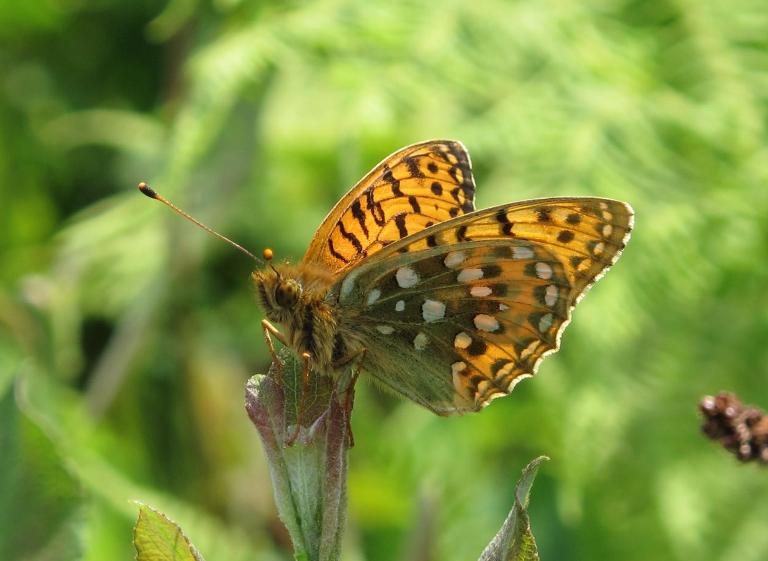
Last week Emily who was on work experience from Ripon Grammar School took this superb shot of a Snipe on the wetland.
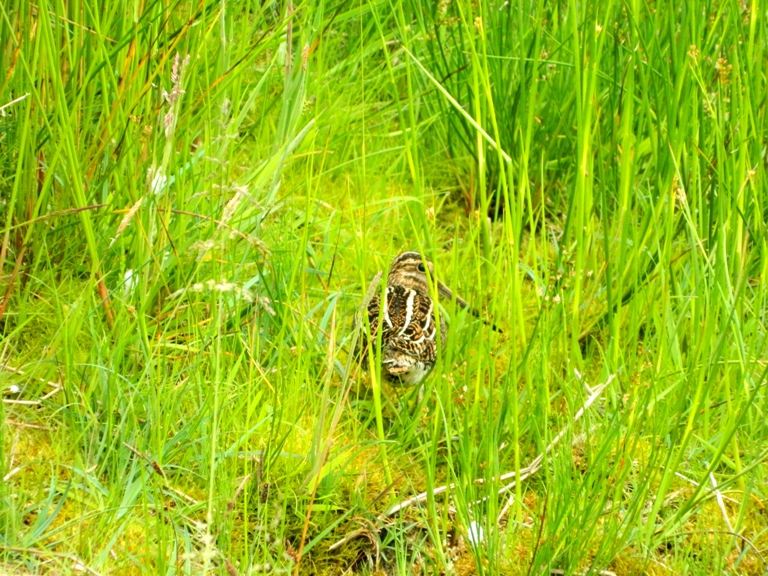
Flowers Galore!
Sunday, July 14th 2013
Warm weather is bringing many flowers into bloom. The Raspberries have finished flowering and now it is the turn of the Blackberries.
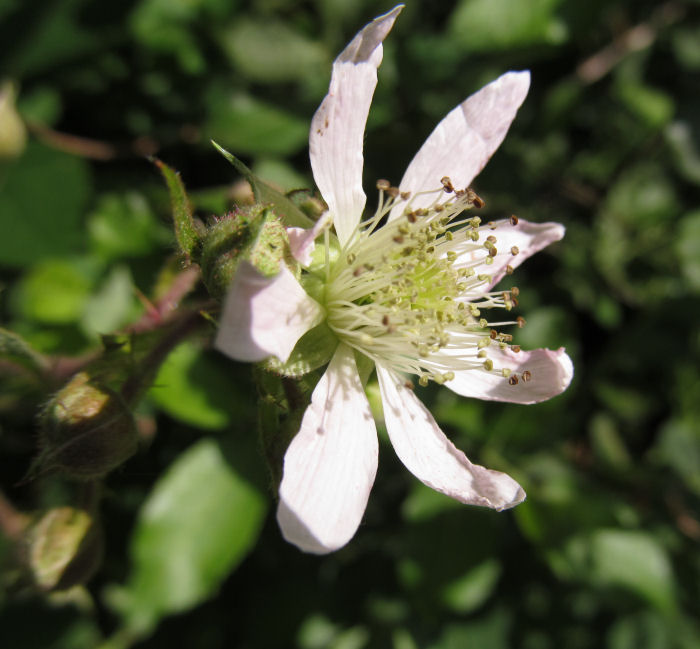
Greater Spearwort has put on a beautiful show in the Scrapes over several weeks. Now it has been joined by the wild roses which scramble through the vegetation.
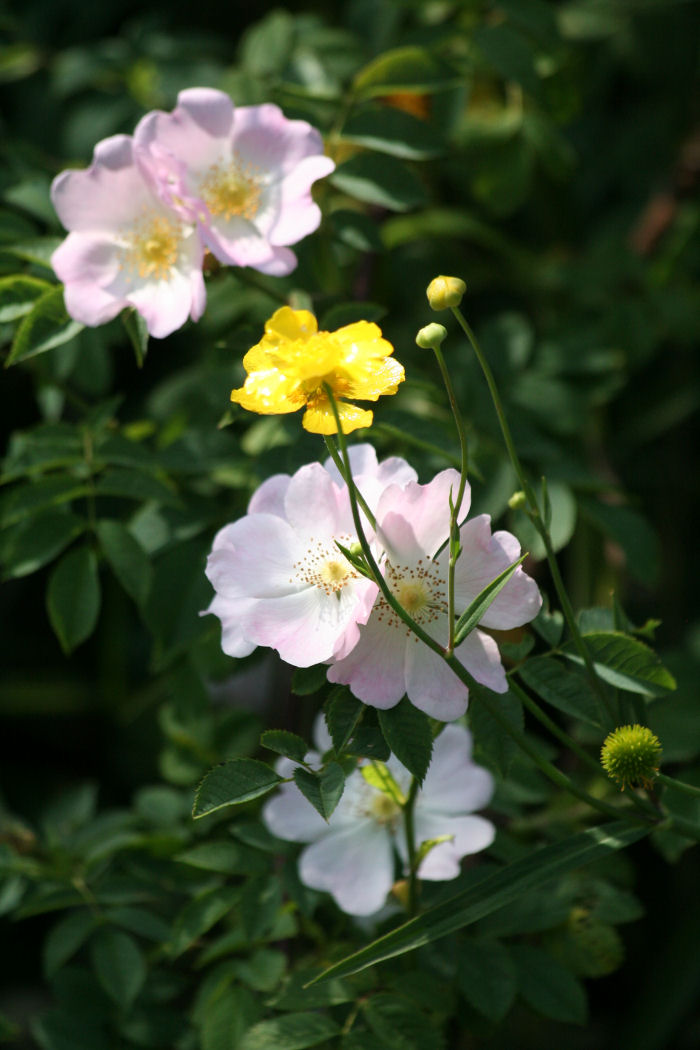
Slender St John's Wort is the first of the St John's Worts to flower. Each year their spots, black and/or red, shape of leaves and stems are examined before identification is confirmed!
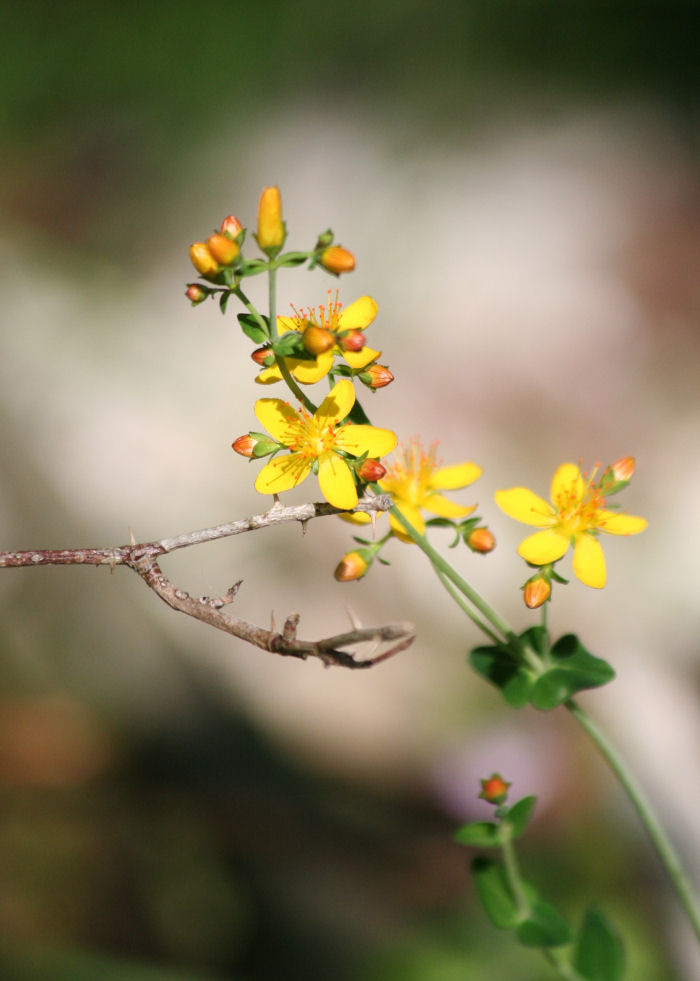
Foxglove volunteers will be so thrilled to know that the thistles are beginning to set seed so 'thistle pulling time' is almost here! You can just see the seeds developing on this thistle head. Many insects love thistles.
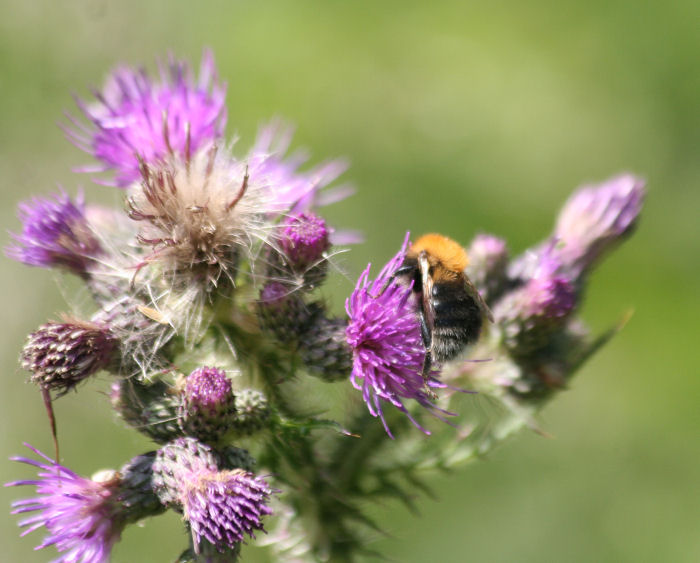
This skipper butterfly is feeding from the nectar, using its long proboscis to reach the nectaries hidden at the base of the flower.
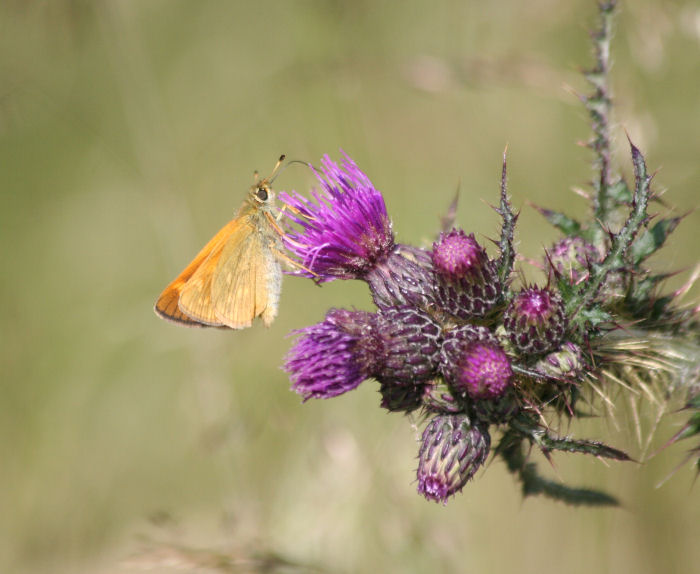
Lakeland Life
Friday, July 12th 2013
The lake is healing well after being re-profiled in 2010. As more and more vegetation appears so do the birds associated with this habitat.
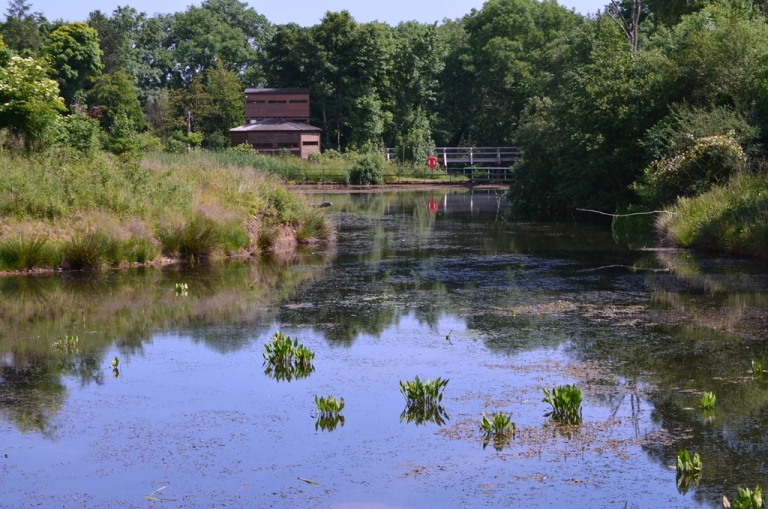
Tufted duck have bred here for the first time in a number of years and the young chicks can be seen following their parents about daily.
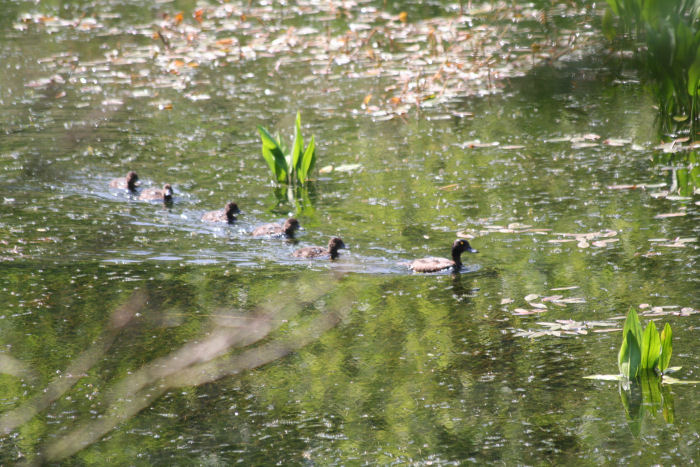
Pied Wagtail often breed close to water. The lakeshore is the perfect place for this fast running bird to see and catch insects.
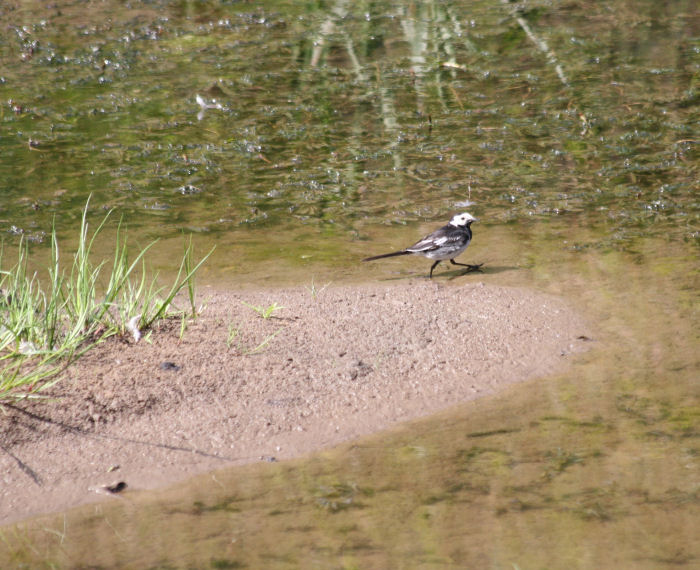
The Grey Wagtail put in several appearances here this week too. It is clear from this picture that the newly planted reeds are growing well.
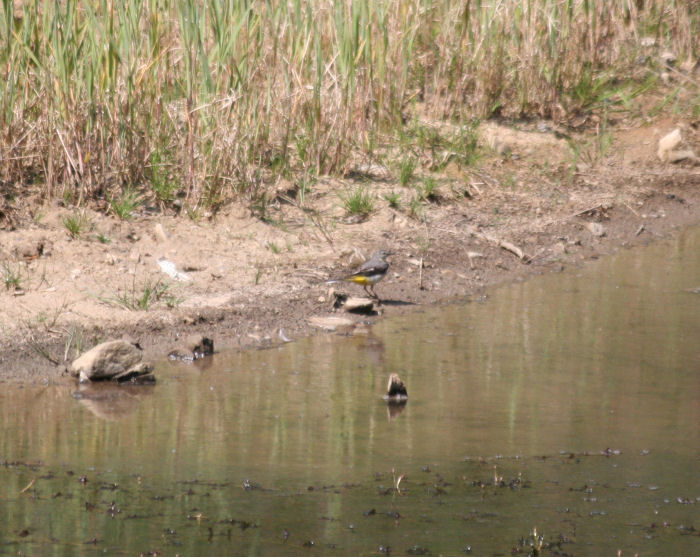
Thank you to Neil and Elizabeth for the photos. A reminder that preparations are well underway for the Bioblitz on the 20th and 21st July. See the events section for details. If you can help out in any way please get in touch with Adam or Sophie. Raffle tickets are now on sale in the Field Centre for the Bioblitz raffle. Prizes include the following:
A Handmade quilt, Saks voucher (for a cut and finish), A hamper of ice cream from R&R Ice Cream Ltd, A hamper from the Angel's Share bakery, Wagg dog food, a family pond-dipping session, Black Sheep Brewery T-shirts, A £10 LIDL voucher, egg cups from Lakeland Ltd and a bottle of Cava! Tickets cost £1 each and the winning tickets will be drawn at 3.00pm on Sunday 21st July.
Rush Control
Thursday, July 11th 2013
Two Dexter cattle from Big Sheep Little Cow (the farm attraction in Bedale) have returned to the wetland to help manage this habitat for wading birds. It is hoped that they will graze some of the rushes that have been flourishing during recent wet summers. Their names are Fern and Loco Rice and so far they have settled down well into their new holiday home.
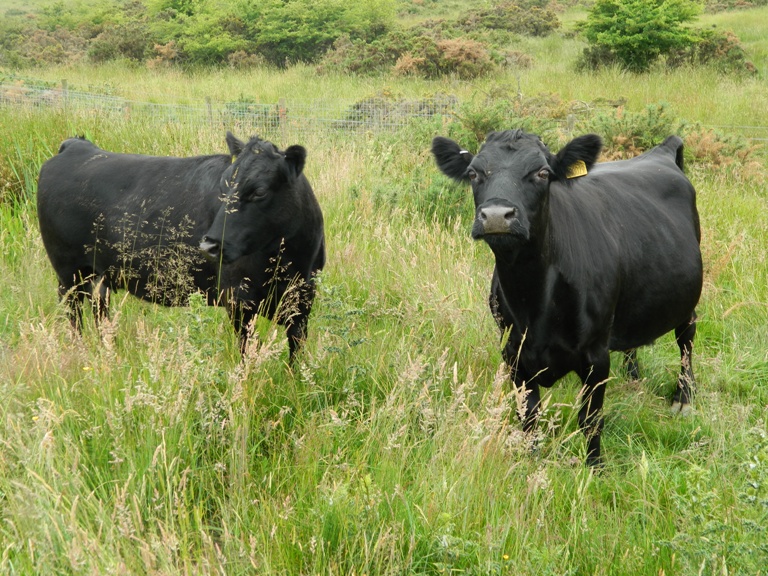
Thank you to Emily for the above photo. Emily, Tony and Mike worked on the moorland to rake up more invasive rush that was brushcut yesterday. This is part of a habitat management plan and Belted Galloway cattle will be re-introduced shortly to graze this patch.
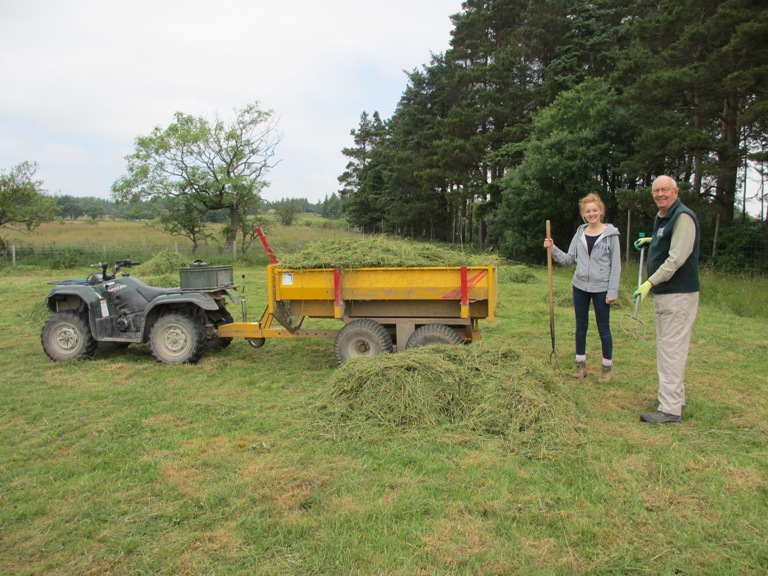
Water Voles have been seen on the wetland this week along with hundreds of butterflies. The House Martins were observed drinking water on the main lake where Tufted Duck (and chicks) were seen too.
Mayhem in the Moth Trap
Wednesday, July 10th 2013
Volunteers spent several hours identifying moths after a bumper catch during the warm still night. Fifty seven species were identified in all with over 300 moths caught – the best catch for a couple of years!

Barred Yellow flies from June to early August. The larvae feed on different species of rose many of which are found here at Foxglove.

Cinnabar Moths are unmistakable flying from mid-May to mid-August. Unlike many moths there is very little variation in this species occasionally the pinkish-red markings are replaced by yellow. The larvae feed on Common Ragwort, where populations are high the plants can be reduced to bare stems.

Ruby Tiger moths made an appearance in the trap again – we were luckier this week and managed to get a picture before it flew off! This moth tends to be associated with open habitats and glades.
Moths are not the only insects attracted to the light trap, caddis flies, a water boatman, midges and this crane fly were also waiting this morning.
Thank you to everone who spent so much time today helping with this and the other tasks on the reserve!
Summer Antics
Tuesday, July 9th 2013
Volunteers spent the day completing varied and interesting tasks in balmy summer temperatures (a far cry from those experienced by the Cape Wrath team last week). Paths were strimmed and overhanging branches were pruned back. Invasive New Zealand Pondweed was also removed from some of the pools close to the Field Centre. A team also worked to finish installing the new boardwalks behind the scrapes.
Sections were wired to make them less slippery in wet weather.
Water Voles have been seen in the Scrapes today and yesterday, all the apple that was left out for them last night was gone by the time we were back in this morning. On the butterfly walk this morning over 60 Ringlets were recorded as well as high numbers of Speckled Wood - the best result so far this season!
Along the Beck
Monday, July 8th 2013
Along the beck is the best place to be on a hot summers day. The shade of the trees is a welcome respite from the sun.
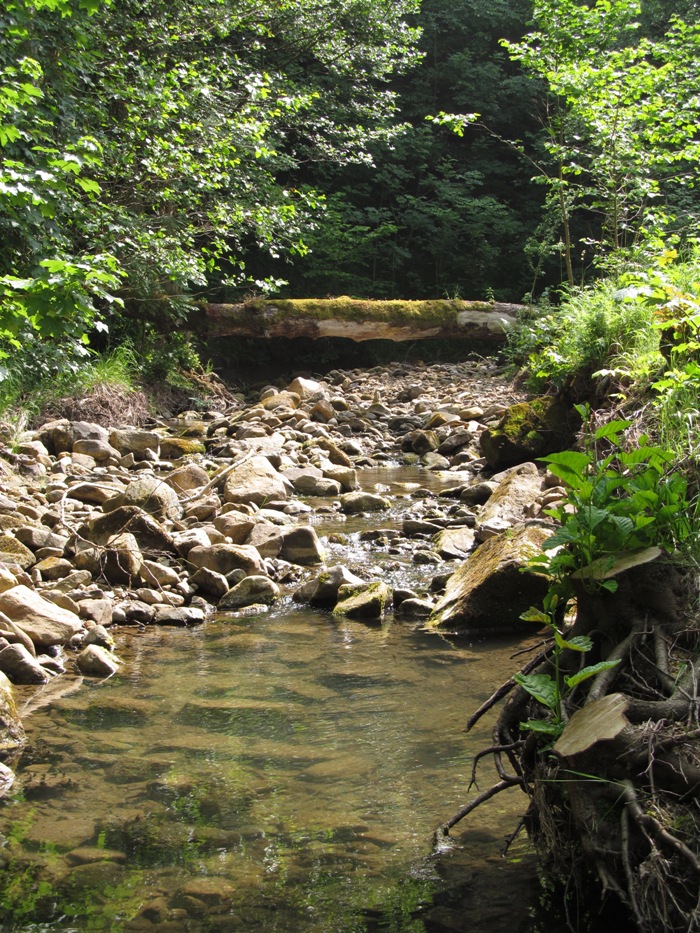
Elizabeth took these photos whilst out 'kick netting' to sample the river life with Brian. They found young Bullheads, various mayfly larvae, leech, flatworm and caddis larvae. This Grey Wagtail also seemed to finding plenty of invertebrates to feed on.

The Grey Wagtail was not the only bird to be enjoying a feast of insects today, out on the moorland flocks of House Martins and Swallows were found swooping low over the lush vegetation, Crossbills were also seen flitting amongst the top of the trees. These House Martins perched high up in a tree and Elizabeth was just quick enough to snap a picture!
Sunny and Warm
Monday, July 8th 2013
A slightly cool morning but as the sun rose so did the temperature. The lovely day was enjoyed by many visitors who walked around the reserve. Damselflies and dragonflies were hunting insects. Bees continued to be busy around many flowers that are now in bloom. Finally the Cotton Grass is ready to release its seeds in the gentle breezes.
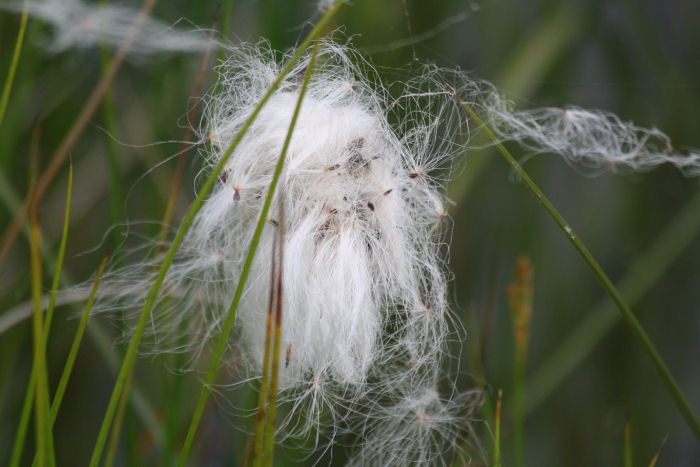
The first ripe Strawberry was pinched, not by a bird! Rowan and Hawthorn berries are developing ready for the birds to feast on in the autumn.
Orchids continue to bloom in many areas of the reserve.
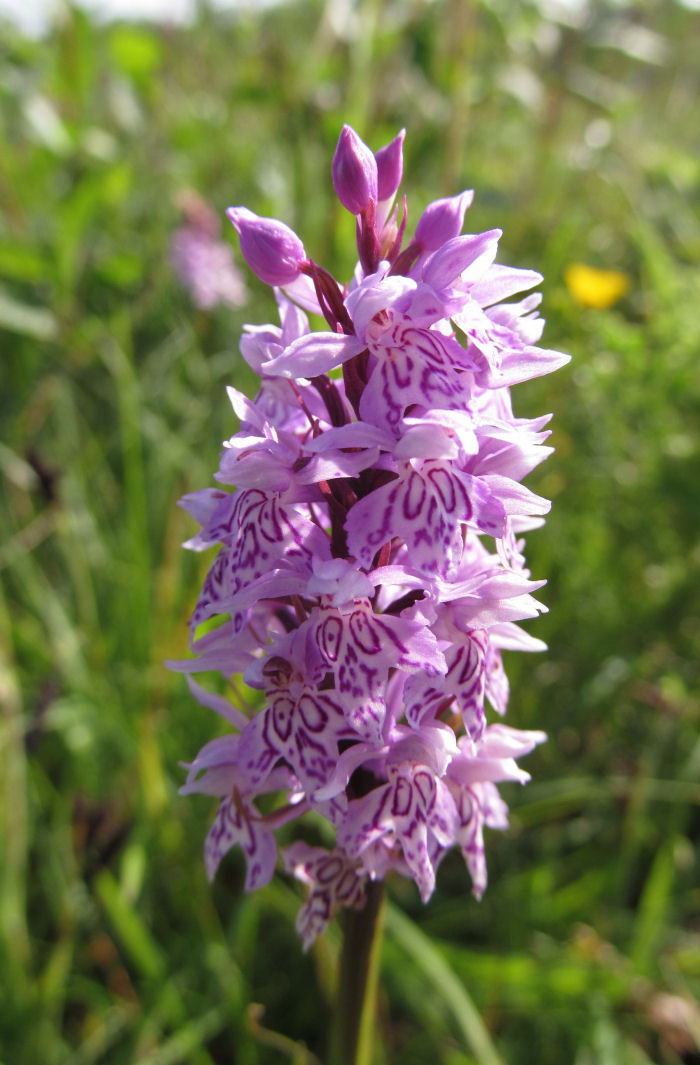
Hidden amongst the grasses, Slender St John's Wort is flowering.
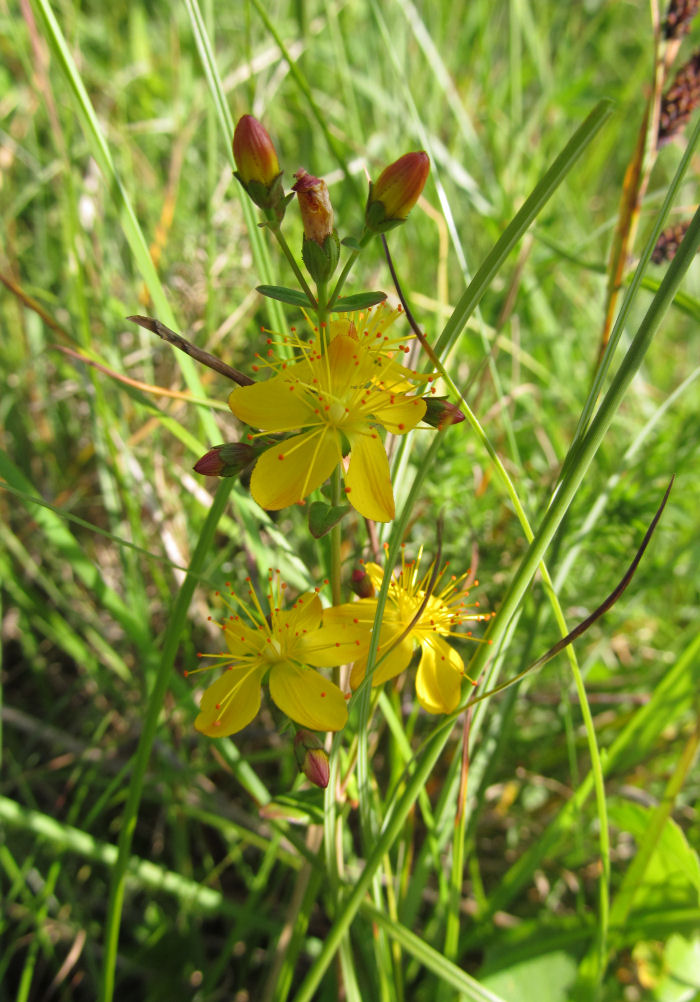
It was CES 7 and as usual, visitors were welcomed into the ringing room. Many juvenile birds were handled, including Robin, Wren and Greenfinch. Great Tits, who have been ringed whilst in nest boxes were also processed. The first young Coal Tit was seen. Most of the resident youngsters are still in juvenile plumage, but the Willow Warbler and Chiffchaff young are well through their moult. In about 6 to 8 weeks they will be heading back to Africa and so will need their plumage in pristine condition.
227 birds were processed by the bird ringers. Although it is said every ringing day, the hard work of the volunteer bird ringers, staff and other volunteers is really appreciated - thank you very much.
Welcome Home!
Saturday, July 6th 2013
Welcome Home! The team from Cape Wrath arrived home this evening. Although the weather has not been kind to them they have achieved a lot and have ringed over 700 birds. All the information, like the data from Foxglove, is sent to the BTO.
It was still very windy today but the sun shone and it was warm. Unfortunately this meant that the insects were really active and sitting still was not an option! The moth trap was set overnight and when emptied, moths flew out very quickly in all directions. On Wednesday morning we caught a Ruby Tiger. This morning a very old Oak or Northern Eggar was caught. There seems to be difficulty in separating the two species, so a photograph will be sent to Dr Fletcher, the moth recorder for VC65. The photographs taken of both species were not very good. However this tiny micro-moth, as yet unidentified, sat very still.
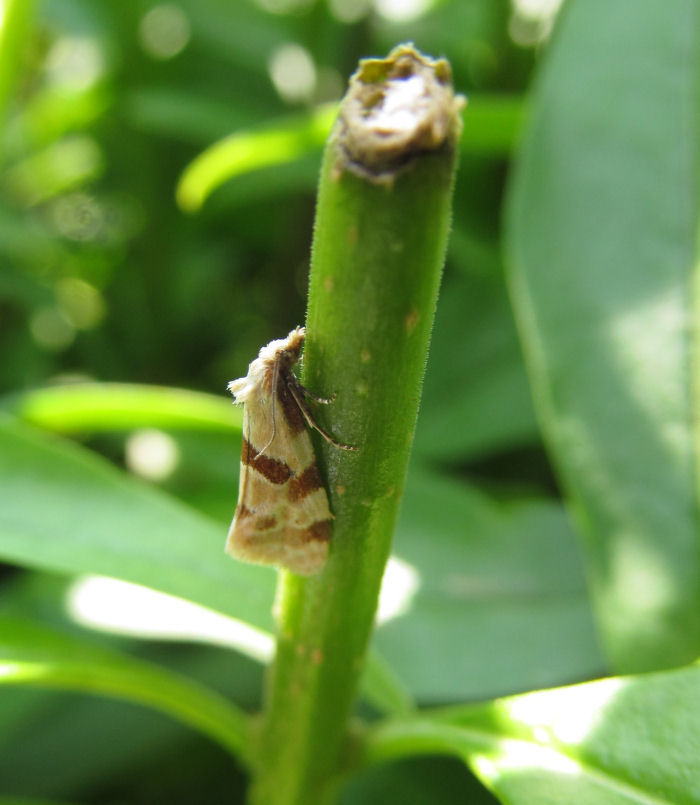
Bumble bees were making the most of the sunshine and were seen in great numbers on Marsh Cinquefoil.
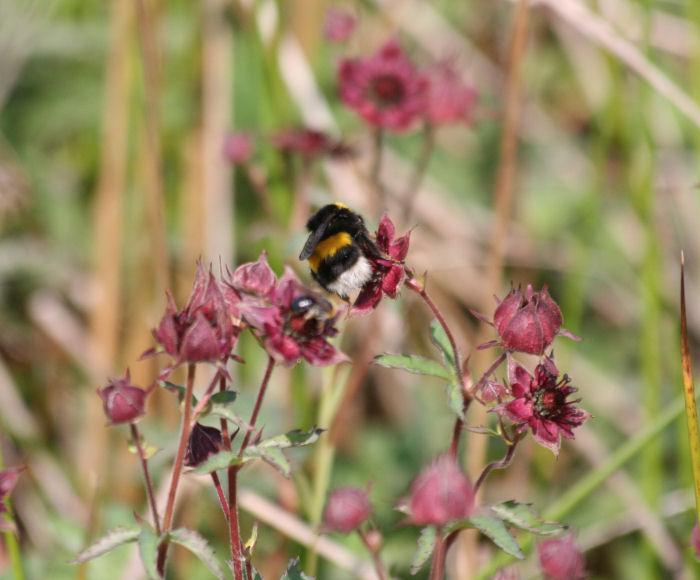
The butterfly survey was carried out this afternoon and Common Blue, Speckled Wood and Ringlet were amongst those recorded.
Here Kitti Kitti!
Friday, July 5th 2013
It is the last full day for the team at Cape Wrath, ringing was planned but the weather had other ideas. An email just said 'white water!'

So getting ready for the journey south was carried out and the boats were packed up ready to start their journey home too.

The rain had blown through on very strong winds and then the blue skies gave excellent opportunities for photographs.

This afternoon the team managed to get out to visit a Kittiwake Colony - they appear not to have been very co-operative!
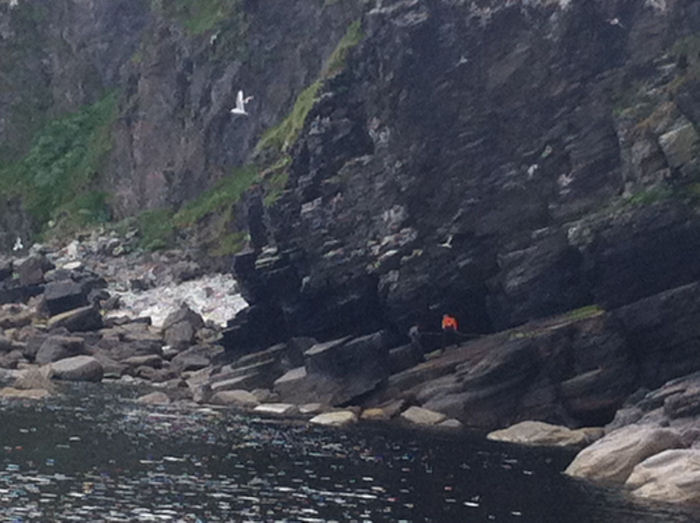
They start their long journey home tomorrow.
After discussion it was decided that the weather had not read the weather forecast as it was meant to be sunny by mid morning at Foxglove. Drizzle continued until lunch time and finally the sun came out about tea time! Although the wind also continued very strong it did not stop the House Martins hunting over the wetland ponds or the Buzzard circling overhead. On the Lake a Tufted Duck has young chicks. They always breed late in the season.
As has already been said the bumble bees are busy, especially around the Raspberries. Today, although not a good photograph, this bee was caught with huge pollen sacs, feeding.
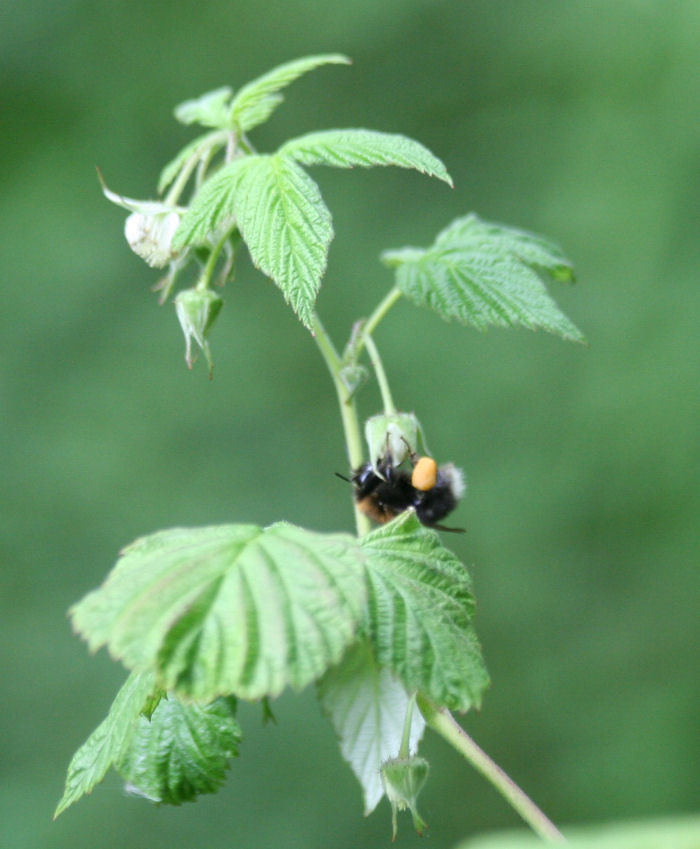
Other flowers that are important to bees are the clovers, Red, Zig-Zag and White (shown below).
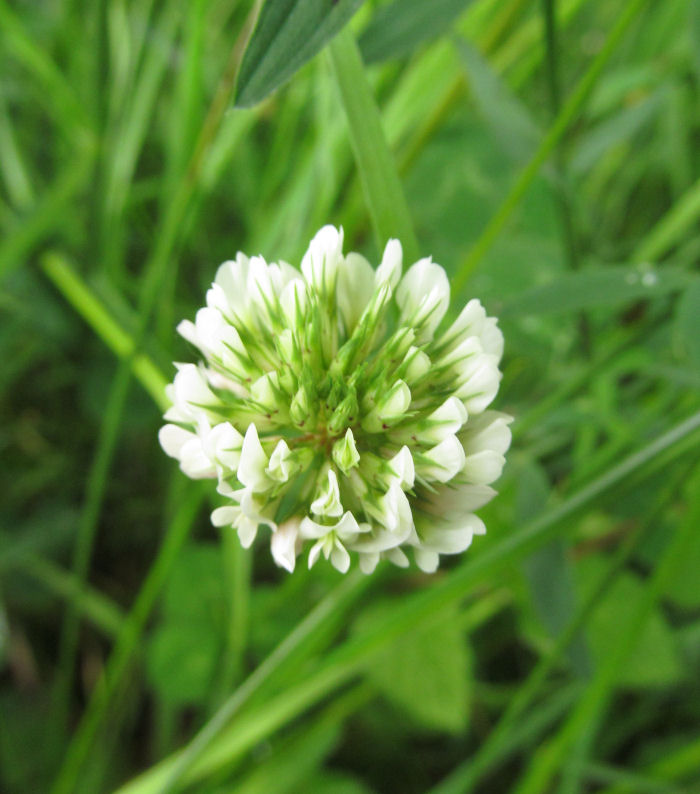
Volunteers were again busy today carrying out a variety of tasks from dusting to pruning, putting holes in pencils for CES papers, checking the orchids and filling the feeders. Thank you very much for your help.
News from the North and News from Foxglove
Thursday, July 4th 2013
Technology continues to work, emails and photos arrive from the North. News from yesterday said that they had been very wet! Emails overnight and this morning are as follows - 'Had a good day on Clo Mhor. So far in total we have ringed 634 of 22 species!' 'At sea again today! Weather reasonable!' and finally 'Will try and send a picture later but not easy as don't want to ruin phone! We are off to sea shortly.' They are now back on land and getting ready for their evening meal prepared by the legendary chef.

This Ringed Plover chick was processed at Kervaig Bay
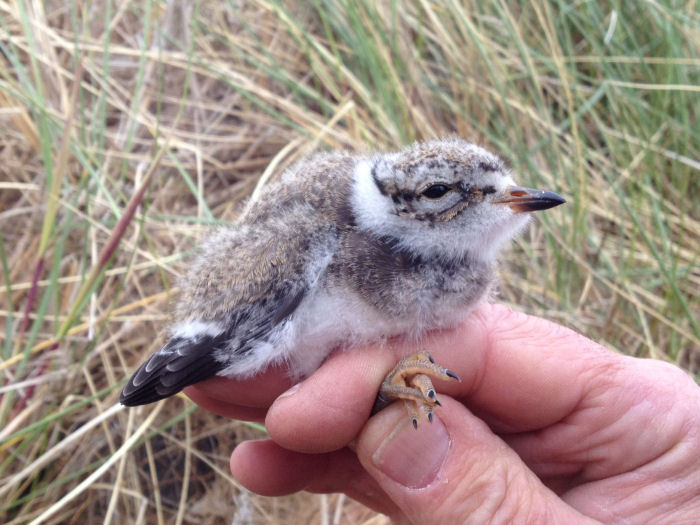
Back at Foxglove, as usual at this time of year, weather permitting, everything is growing! In the sunshine the bumble bees are very active, especially around the Raspberry flowers. They are so busy, photographing them is difficult, however this one settled and stayed still, on a Greater Spearwort flower just long enough to be caught on camera.
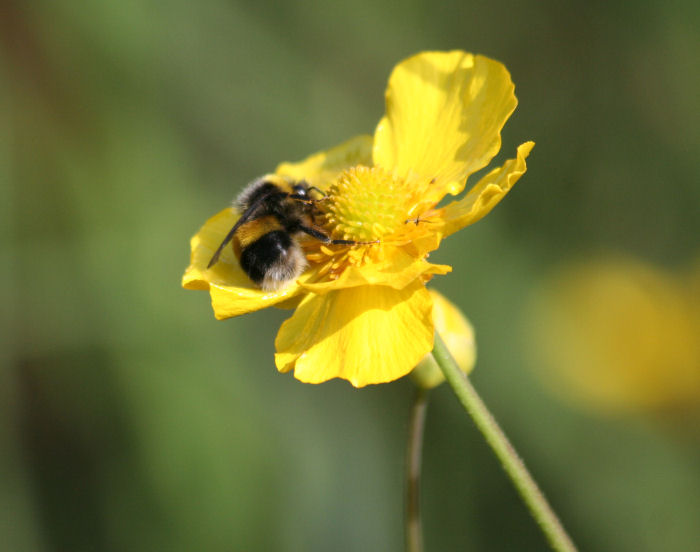
Around the area roses have been blooming but those on the reserve have been slow to unfurl their petals but at last they are blooming.
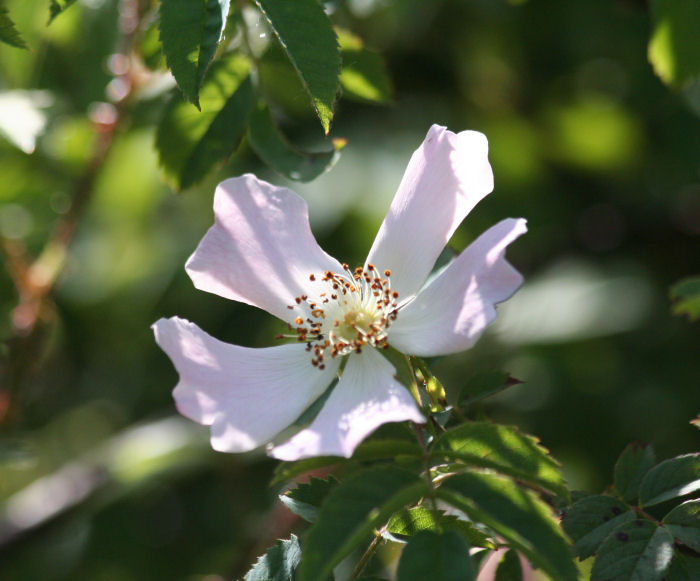
Last year at this time the volunteers were at the stage of never ever wanting to see another thistle! They had spent considerable time pulling them up to stop them spreading their seeds. Apologies to the volunteers but this photograph of a Creeping Thistle was just lovely! A little while to go before you are back pulling them all up again!
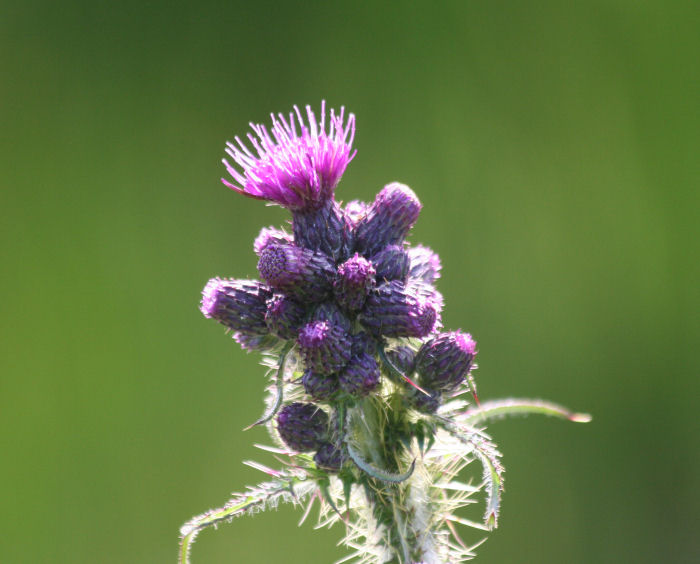
The moth trap was set last night and when emptied this morning it was really hot inside so the moths were rather active! However this Poplar Hawkmoth just chilled on the vegetation.
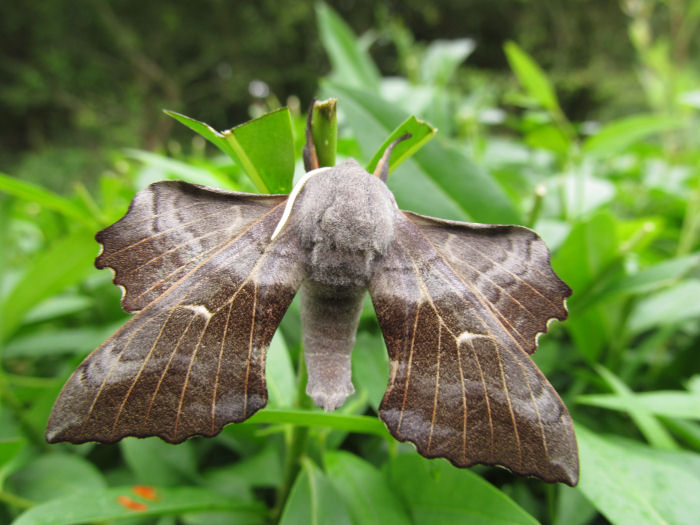
Volunteers worked on a variety of tasks today including finding the drains, cutting a hedge, identifying the moths, checking the paths and looking for wood for our next venture for certain minibeasts. Thank you very much for all your help.
Just Beautiful
Wednesday, July 3rd 2013
Later last night after the blog was finished, two further photographs arrived from the North (Isn't technology amazing!). The first is of Kervaig Bay. Even in less than good weather it still looks beautiful and impressive.
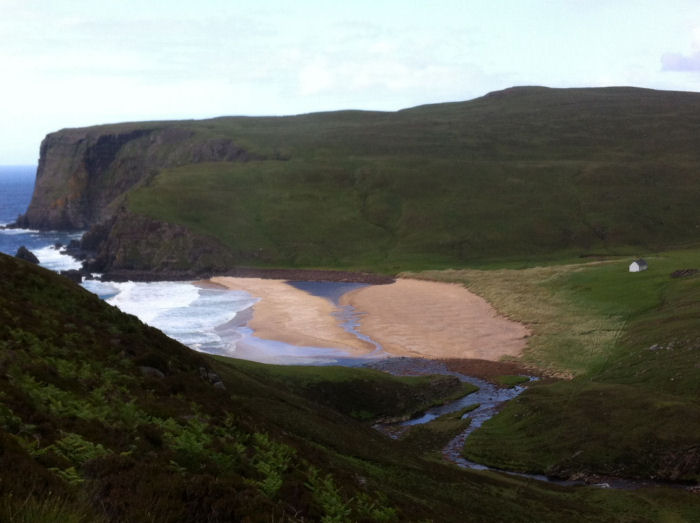
A little different, the second was entitled 'Pudding!' Their chef looks after them well.

Spot the Road, Spot the Boat.
Tuesday, July 2nd 2013
News from the North arrived South last night and this morning along with some photographs. The weather is not good with strong winds and rain. Cape Wrath is off the beaten track so it is to be expected that that the roads are not beautifully surfaced. This is the road.

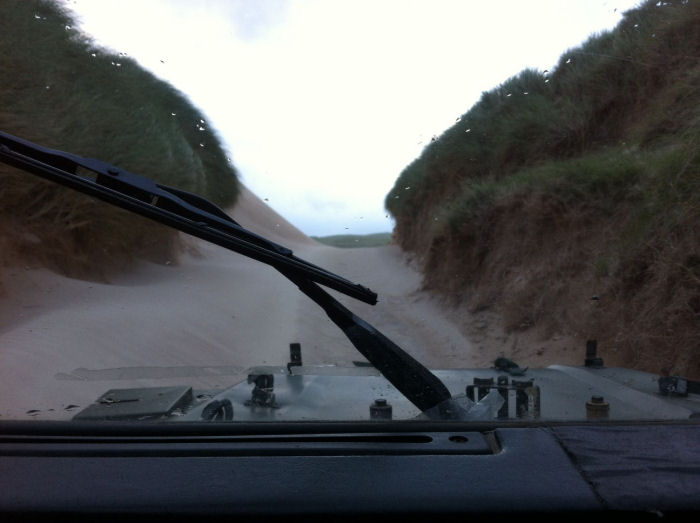
Further news stated that one of the boats that is used to ferry them to the offshore islands had capsized. No one was in it at the time. (It is the one with the red marker buoy.)
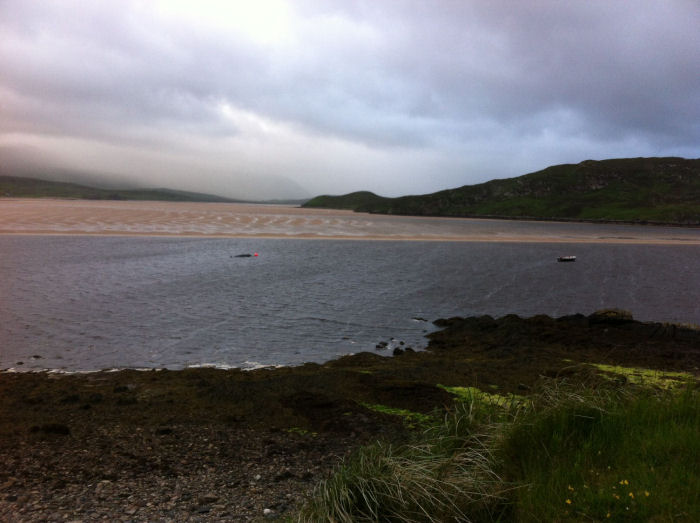
This morning work went ahead to refloat the boat.
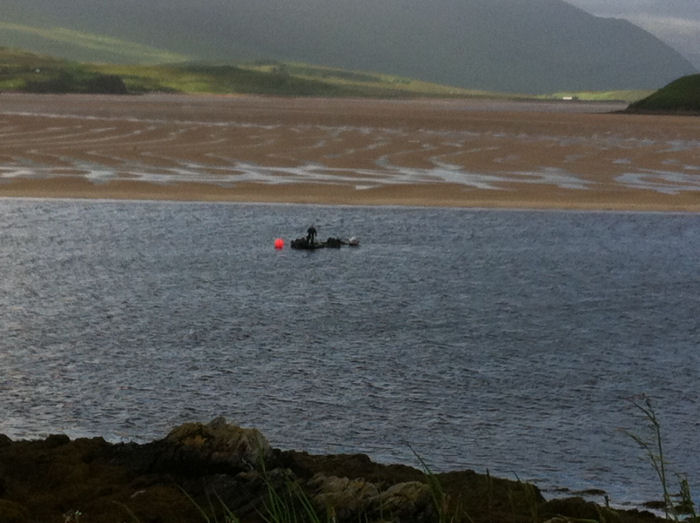
Apparently all it needs now is a new engine!
On the way up the group ringed birds at Loch Torridon and on one of the islands, surprisingly they found a Barn Owl. They also ringed Great Black-backed Gulls, Common Gulls, Herons and Cormorants. Over the weekend Sandwich Terns, Herring Gulls, Black-headed Gulls and Red Breasted Mergansers were added to the list.
A Buzzard chick was also ringed. It is much younger than those ringed over the last couple of years.
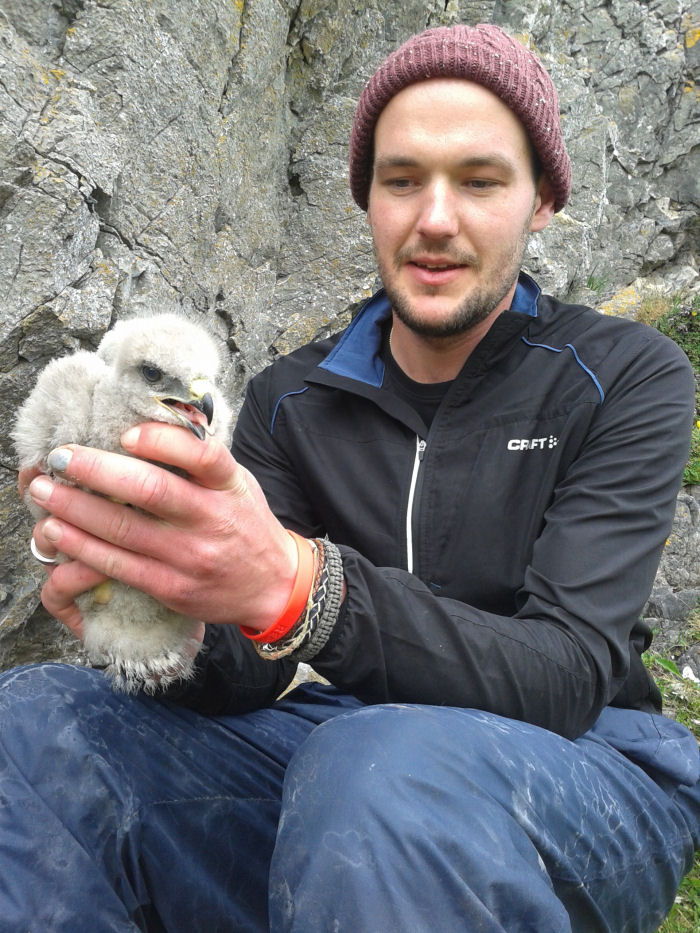


.JPG)
.JPG)
.JPG)













